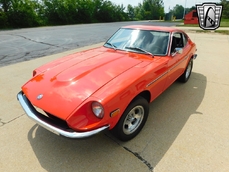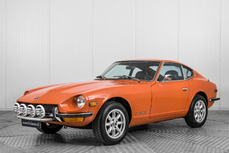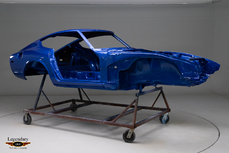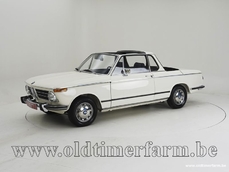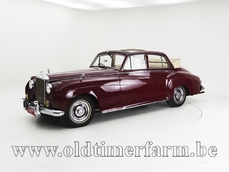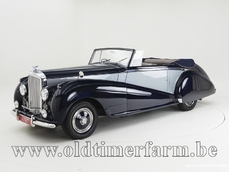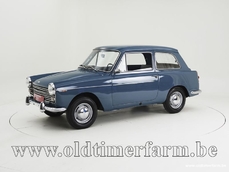Datsun 240Z '72 1972
General description :
Lowered price from €31.950 - €29.950 The Nissan S30 (sold in Japan as the Nissan Fairlady Z and in other markets as the Datsun 240Z, then later as the 260Z and 280Z) was the first generation of Z GT coupes, produced by Nissan Motors from 1969 to 1978. One of the most successful sports car lines ever produced, the trend-setting S30 was designed by a team led by Yoshihiko Matsuo, the head of Nissan's Sports Car Styling Studio. Seeking to compete with established European sports cars, Datsun priced the new 240Z within $200 of the British MGB-GT in the United States. The 240Z's sleek styling, modern engineering, relatively low price, and impressive performance struck a major chord with the public. Positive response from both buyers and the motoring press was immediate, and dealers soon had long waiting lists for the "Z". The 240Z broadened the acceptance of Japanese car-makers beyond their econobox image. Datsun's growing dealer network compared to limited production imported sports cars manufactured by Jaguar, BMW, Porsche, Alfa Romeo etc. ensured both easy purchase and ready maintenance. The 1970 through the mid-1971 model year 240Z was referred to as the Series I. These early cars had many subtle but notable features differing from later cars. The most easily visible difference is that these early cars had a chrome 240Z badge on the sail pillar, and two horizontal vents in the rear hatch below the glass molding providing flow through ventilation. In mid-1971, for the Series II 240Z-cars, the sail pillar emblems were restyled with just the letter Z placed in a circular vented emblem, and the vents were eliminated from the hatch panel of the car. Design changes for the US model 240Z occurred throughout production, including interior modifications for the 1972 model year, and a change in the location of the bumper over-riders, as well as the addition of some emission control devices and the adoption of a new style of emissions reducing carburetors for the 1973 model year. The 1970 models were introduced in October 1969, received the L24 2.4-liter engine with a manual choke and a four-speed manual. A less common three-speed automatic transmission was optional from 1971 on, and had a "Nissan full automatic" badge. Specifications Bodywork Length : cm (in): 414 (162.8) Width : cm (in): 163 (64.2) Height : cm (in): 129 (50.6) Wheelbase : cm (in) : 231 (90.7) Weight: kg (lb) : 1070 Mechanics. Displacement : straight-six 2393 cc, front-mounted Valve gear : 12 Fuel system : 2 SU carburettors Gearbox : 5-speed manual Drive wheels : rear-wheel drive Maximum power : 147 hp at 6000 rpm Maximum torque : 197 Nm at 4400 rpm Maximum speed : 200 km/h (124 mph)
http://www.oldtimerfarm.be/en/collection-cars-for-sale/4896/datsun-240z-72.php
1972 Datsun 240Z '72 is listed sold on ClassicDigest in Aalter by Oldtimerfarm Dealer for €29950.
Car Facts
Car type : Car Make : Datsun Model : 240Z Model Version : '72 Engine size : 0.0 Model Year : 1972 Location : Aalter
Sold
Seller Information
Sold
People who viewed this Datsun 240Z also viewed similar Datsun listed at ClassicDigest
Other cars listed for sale by this dealer
About Datsun
Once upon a time in the mystical land of Japan, there was a small, unassuming car company called Datsun. Legend has it that the name "Datsun" was created when someone dropped a bunch of Scrabble tiles and thought, "Sure, that'll do!" Datsun started with small, quirky cars that made you wonder if they were more suited for a toy store than a car dealership.In the 1950s, Datsun had a brilliant idea: "Let's try our luck in the American market!" They shipped over the Datsun 1000, a car so tiny that even a clown could drive it comfortably. Americans scratched their heads but soon fell in love with its compact cuteness. It was like adopting a small, four-wheeled puppy.
As the '60s rolled in, Datsun unveiled the 240Z, a sports car that could outrun a samurai in flip-flops. It had the speed of a cheetah and a design that turned heads faster than a ninja on roller skates. The 240Z became an instant classic and showed that Datsun was more than just quirky little cars.
In the '70s, Datsun dropped the 510, a sedan with the agility of a ninja and a suspension so smooth, it could make you believe you were floating on a cloud. Families across America hailed it as the car that could carry everything – from groceries to grandmas – without breaking a sweat.
But the real magic happened when Datsun revealed the Datsun 510 wagon. It was like Mary Poppins' bag, fitting more stuff than seemed humanly possible. This wagon was an enigma, a mystery, and America couldn't get enough.
Then, in the '80s, Datsun pulled a fast one and changed their name to Nissan, leaving us all a bit befuddled. But they continued making fantastic cars that were zippier than a sushi chef on a Saturday night.
And that's the whimsical tale of how Datsun – or should I say, Nissan – took over the American market, one quirky yet lovable car at a time.
As for the most influential Datsun models and their specs:
Datsun 240Z: The 240Z was a sports car sensation. It featured a 2.4-liter inline-six engine, producing around 150 horsepower. With rear-wheel drive and a sleek design, it was a blast to drive and a style icon of its time.
Datsun 510: The Datsun 510, available as a sedan and wagon, was loved for its handling and durability. It typically came with a four-cylinder engine, producing around 96 horsepower, and was known for its agile suspension.
Datsun 510 Wagon: The Datsun 510 Wagon was like a Tardis, with a deceptively spacious interior. It shared the same engine as the sedan and provided exceptional versatility for families on the go.
These Datsun models left an enduring legacy with their quirky charm, performance, and practicality, making them cherished classics in the hearts of car enthusiasts and families alike.
Oh, one more thing...years after BMW made a copy or the 510 and decided to call it e30. Strange world!



